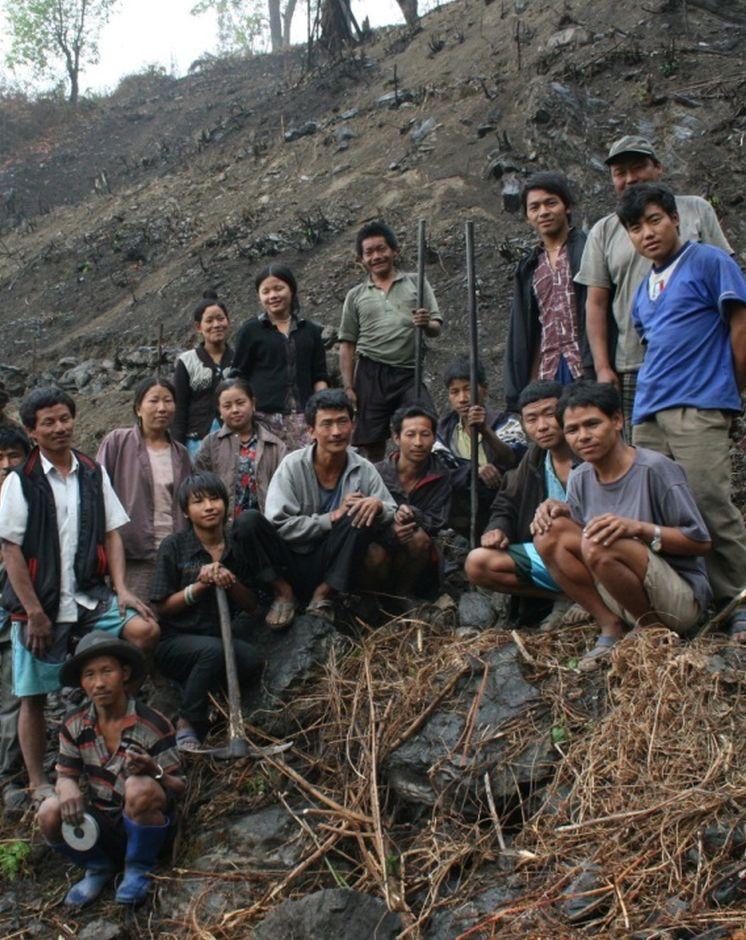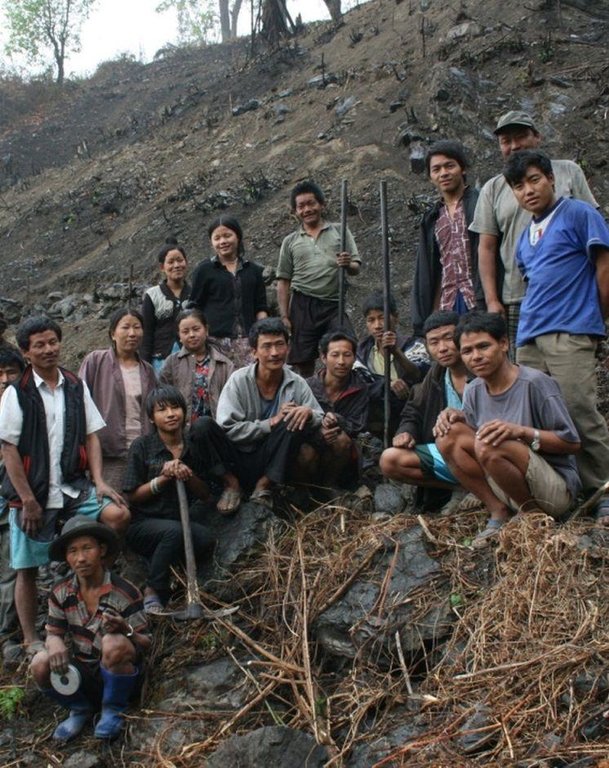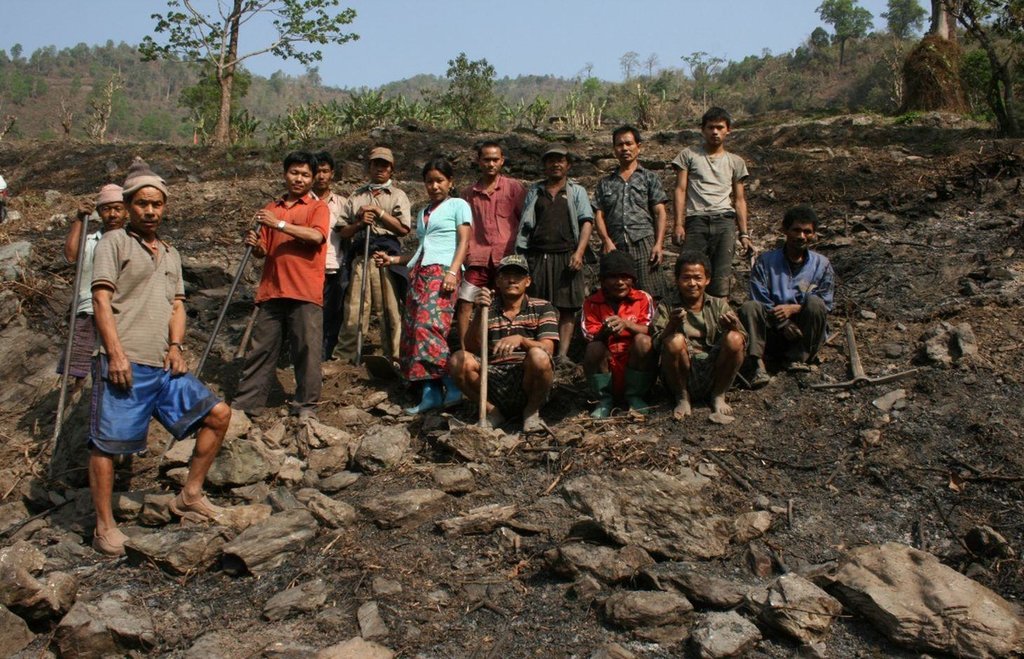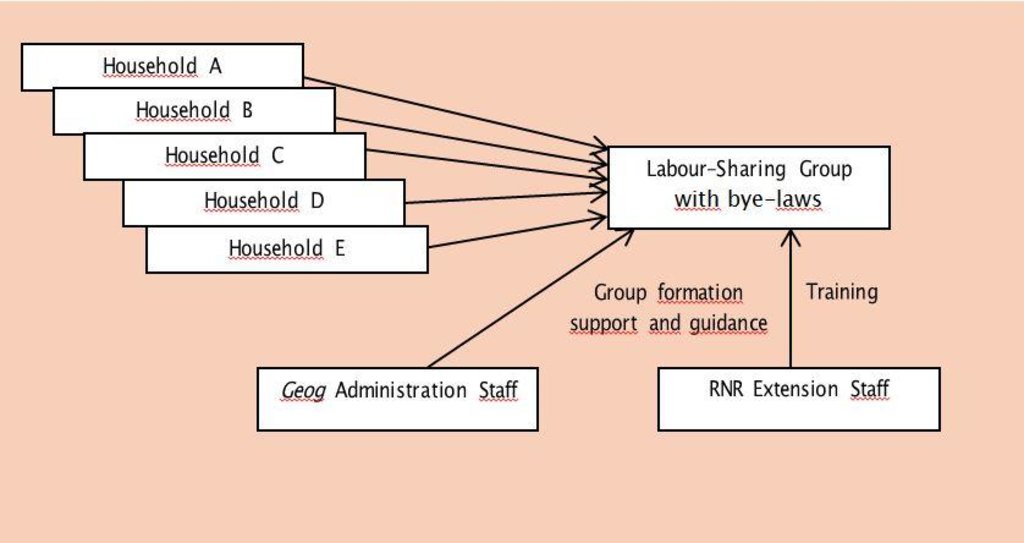SLM Labour-Sharing Group [不丹]
- 创建:
- 更新:
- 编制者: Karma Dorji
- 编辑者: –
- 审查者: Fabian Ottiger
approaches_2491 - 不丹
查看章节
全部展开 全部收起1. 一般信息
1.2 参与方法评估和文件编制的资源人员和机构的联系方式
有助于对方法进行记录/评估的机构名称(如相关)
MoA (MoA) - 不丹有助于对方法进行记录/评估的机构名称(如相关)
National Soil Services Centre (National Soil Services Centre) - 不丹1.3 关于使用通过WOCAT记录的数据的条件
(现场)数据是什么时候汇编的?:
21/03/2011
编制者和关键资源人员接受有关使用通过WOCAT记录数据的条件。:
是
1.4 SLM技术问卷的参考
2. SLM方法的描述
2.1 该方法的简要说明
Labour-sharing group at village and sub-village level to ease the labour constraint faced by many households.
2.2 该方法的详细说明
该方法的详细说明:
Aims / objectives: A labour-sharing group is a pool of land-users, who work on rotation basis on the plots of the different group members and replaces the conventional approach of an individual land user carrying out a specific SLM intervention. An important constraint for effective implementation of SLM interventions is the lack of sufficient labour force at household level. To tackle this key issue, groups are formed at village and sub-village level to enable these households to take up the relatively labour-intensive SLM activities, such as stone bunding, bench terracing, stone check dam construction, water source protection works or grass hedgerow development.
Methods: The labour-sharing group is given an initial practical training on the basics of the SLM intervention, which start with hands-on work on the land of a group member, preferably that of a vulnerable household, which otherwise would have difficulty to provide sufficient labour to take up the activity. Labour-sharing groups therefore facilitate the inclusion of vulnerable households, especially female-headed and small families, in the implementation of labour-intensive SLM inter-ventions. In addition to the technical guidance provided by the extension staff, support is given to the group formation process, such as drafting of informal by-laws and group management.
Stages of implementation: Labour-sharing groups enable households to carry out key SLM interventions more effectively and efficiently enabling them to cover as compared to individual household approach. Other co-benefits reported are the improved community sense and enhanced social cohesion, because the exchange of experiences and collaboration builds mutual trust. Working in a group eases hard physical work, such as carrying and breaking large boulders and is perceived to be much more enjoyable than working alone or in a small household setting.
Role of stakeholders: Groups that were formed for the implementation of a specific SLM activity often continue carrying our other planned SLM interventions in a group. In some villages communities reported that they had lost the former practice of labour-sharing, but that with reintroduction by the project their community sense has been rejuvenated. Sustainability of the labour-sharing approach has to be proven post-project. Additional costs are very limited and are restricted to group formation guidance and some additional group support, such as tool sets and more incentives as more land will be converted by the group approach.
2.3 该方法的照片
2.5 采用该方法的国家/地区/地点
国家:
不丹
区域/州/省:
Chhukha Dzongkhag
有关地点的进一步说明:
Logchina geog, Amallay chiog
2.6 该方法的开始和终止日期
注明开始年份:
2009
终止年份(若不再采用该方法):
2012
2.7 方法的类型
- 基于项目/方案
2.8 该方法的主要目的/目标
The Approach focused on SLM only
- To ease the existing labour constraint of individual households by pooling labour force into a common pool, ensuring a more time-efficient labour approach, enabling the group to convert larger areas of land.
- To facilitate the inclusion of vulnerable households in more labour-intensive long-term SLM interventions, for which they otherwise would not have the meansto participate.
- To improve community cohesion through improved trust, understanding, social fencing and “labour joy” (“it is much more fun to work in a group than to sweat individually”).
The SLM Approach addressed the following problems: - SLM interventions, as prioritized in chiog SLM action plan, are very labour-intensive, while labour is increasingly becoming a serious constraint in many rural areas of Bhutan, because of rural-urban migration, off-farm labour and other developmental activities.
- Vulnerable households, single-headed families and poorest families, have often the most difficulty providing sufficient labour for long-term SLM interventions
- Communities often face problems in achieving the targeted area of land to be converted to a more sustainable SLM practice, because of labour shortage.
2.9 推动或妨碍实施本办法所适用的技术的条件
社会/文化/宗教规范和价值观
- 阻碍
Some issues with households who do not share sufficient labour / fail to show up
Treatment through the SLM Approach: Informal by-laws, penalty system, social fencing
法律框架(土地使用权、土地和水使用权)
- 启动
The existing land ownership, land use rights / water rights greatly helped the approach implementation: Individual titled land tenure greatly facilitates motivation and commitment of households to participate in group approach as they are direct beneficiaries.
工作量、人力资源可用性
- 阻碍
SLM interventions often require considerable hard physical labour, in a society where labour force increasingly is becoming scarcer.
Treatment through the SLM Approach: Pool individual households in a group and work on rotation basis on each other’s land
3. 相关利益相关者的参与和角色
3.1 该方法涉及的利益相关者及其职责
- 当地土地使用者/当地社区
self initiative during planning cycle
Slight differences in participation level in the most physically challenging activities such as stone bunding, but also partly culturally determined if there is gender bias in participation. In less physically demanding activities participation is equally divided.The most vulnerable households are included in the labour-sharing group, just as the “better off” families; inclusion of vulnerable households is definite advantage of approach, and an important objective.
- SLM专家/农业顾问
- 地方政府
Local government (geog staff, chiog representatives) and local community
- 国家政府(规划者、决策者)
3.2 当地土地使用者/当地社区参与该方法的不同阶段
| 当地土地使用者/当地社区的参与 | 指定参与人员并描述活动 | |
|---|---|---|
| 启动/动机 | 互动 | Participatory SLM Action Planning |
| 计划 | 互动 | Participatory SLM Action Planning; Schedule of rotation compiled by group members |
| 实施 | 互动 | Training / capacity building at kick-off of group formation process; stone bunding, hedgerow establishment, bench terracing, stone check dam construction, bamboo and tree plantation, water source protection works and grass strip establishment |
| 监测/评估 | 互动 | Participatory Monitoring & Evaluation meetings to give feedback and make adjustments / give guidance |
| Research | 无 |
3.3 流程图(如可用)
具体说明:
Labour-sharing group and its governance
作者:
Hans van Noord (Schoutenkamp 43 Heteren The Netherlands)
3.4 有关SLM技术选择的决策
具体说明谁有权决定选择要实施的技术:
- 主要是土地使用者,由SLM专家提供支持
解释:
Decisions on the method of implementing the SLM Technology were made by mainly by land users supported by SLM specialists
4. 技术支持、能力建设和知识管理
4.1 能力建设/培训
是否为土地使用者/其他利益相关者提供培训?:
是
明确受训人员:
- 土地使用者
培训形式:
- 在职
- 农民对农民
- 示范区域
涵盖的主题:
Training programme for specific SLM interventions, carried out by the labour-sharing group after initial capacity building and hands-on practice sessions; additional group formation support and guidance by the municipality administration staff and extension staff.
4.2 咨询服务
土地使用者有权使用咨询服务吗?:
是
指明是否提供了咨询服务:
- 在土地使用者的土地上
- 在固定中心
说明/注释:
Name of method used for advisory service: Group formation process guidance; Key elements: by-law formulation, demo trainings, exchange visit; By extension staff and geog administration staff in group formation process and during ad hoc visits and regular participatory M & E meetings.
Advisory service is quite adequate to ensure the continuation of land conservation activities; Some need for refreshing/additional training of SLM techniques
4.3 机构强化(组织发展)
是否通过这种方法建立或加强了机构?:
- 是,非常
具体说明机构的强化或建立程度:
- 本地
具体说明支持类型:
- 财务
- 能力建设/培训
- 设备
提供进一步细节:
Group formation process guidance: training and continued support by extension and geog administration staff.
4.4 监测和评估
监测和评估是该方法的一部分吗?:
是
注释:
bio-physical aspects were regular monitored by project staff, government, land users through measurements; indicators: Regular measurements by project staff and group members: area converted, of dams built etc.
technical aspects were regular monitored by project staff, government, land users through observations; indicators: Regular observations by project staff and group members: implementation according to technical guidelines (distances between bunds/hedges, survival rate of seedlings etc.
socio-cultural aspects were regular monitored by project staff, government, land users through observations; indicators: Regular observations by project and geog administration staff and group members regarding group functioning and possible conflicts (drafting of by-laws, rules etc.)
economic / production aspects were regular monitored by project staff, land users through measurements; indicators: Regular measurements by project staff and group members: crop yield, production area increase
area treated aspects were regular monitored by project staff, land users through measurements; indicators: Regular measurements by project staff and group members: area treated
no. of land users involved aspects were None monitored by project staff, land users through measurements; indicators: Regular measurements by project staff and group members: # of households
management of Approach aspects were None monitored by project staff, government, land users through observations; indicators: Regular M & E meetings with project and geog administration staff and group members
There were few changes in the Approach as a result of monitoring and evaluation: Drafting and adoption of group by-laws to regulate agreements and as enforcement of “social fencing”
There were few changes in the Technology as a result of monitoring and evaluation: slight changes in technical guidelines after group feedback.
5. 融资和外部物质支持
5.1 该方法中SLM组成部分的年度预算
如果不知道准确的年度预算,请给出一个范围:
- < 2,000
注释(例如主要的资助来源/主要捐助者):
Approach costs were met by the following donors: government (SLMP project support: tools, training, incentives): 5.0%; local community / land user(s) (labour contribution): 95.0%
5.2 为土地使用者提供财政/物质支援
土地使用者是否获得实施该技术的财政/物质支持?:
是
如果是,请具体说明支持的类型、条件和提供者:
Incentive per area converted to sustainable SLM practice and seeds/seedlings.
5.3 对特定投入的补贴(包括劳动力)
- 设备
| 具体说明哪些投入得到了补贴 | 程度如何 | 对补贴做出具体说明 |
|---|---|---|
| 工具 | 充分融资 | |
- 农业
| 具体说明哪些投入得到了补贴 | 程度如何 | 对补贴做出具体说明 |
|---|---|---|
| 种子 | 部分融资 | maize, mustard, potato, wheat, paddy, vegetables |
注释:
Incentives cover mainly labour contribution as provided by the group members and is mostly only a minor fraction of the actual labour costs.
5.4 信用
是否根据SLM活动的方法给予信用值?:
否
6. 影响分析和结论性陈述
6.1 方法的影响
该方法是否帮助土地使用者实施和维护SLM技术?:
- 否
- 是,很少
- 是,中等
- 是,支持力度很大
Labour-sharing has resulted in the possibility to convert/treat larger areas per working day and has made the work much easier (lifting of heavy stones etc.). More land has now become cultivated through labour-sharing group involvement as could have been done through individual households.
该方法是否有助于社会和经济弱势群体?:
- 否
- 是,很少
- 是,中等
- 是,支持力度很大
Targeted inclusion of vulnerable households in group, even if they have not sufficient labour to contribute to labour pool; hands-on training starts on land of most vulnerable/poor households to give them first benefit.
Did other land users / projects adopt the Approach?
- 否
- 是,很少
- 是,中等
- 是,支持力度很大
Other villages have followed the example of the initial groups.
Did the Approach lead to improved livelihoods / human well-being?
- 否
- 是,很少
- 是,中等
- 是,支持力度很大
Group members express satisfaction over improved social cohesion and interaction because of built trust and understanding and social bonding; group work has contributed to enhanced food self-sufficiency.
Did the Approach help to alleviate poverty?
- 否
- 是,很少
- 是,中等
- 是,支持力度很大
Through improved food self-sufficiency, increased production area/improved cropland area and targeted inclusion of most vulnerable households that otherwise could not have participated in specific labour-intensive SLM activity
6.2 土地使用者实施SLM的主要动机
- 增加生产
- 减少工作量
- 支付/补贴
- 加入运动/项目/团体/网络
- 环境意识
6.3 方法活动的可持续性
土地使用者能否维持通过该方法实施的措施(无外部支持的情况下)?:
- 是
若是,请说明如何维持:
Existing group approach seems well suited to continue post-project, also as it partly is a rejuvenated traditional practice to share labour in a community group.
6.4 该方法的长处/优点
| 土地使用者眼中的长处/优势/机会 |
|---|
|
Eases work (breaking stones, carrying etc.). A-frame running helps to have better lines. Continuous smooth work wit many Social cohesion / experience sharing (How to sustain/ enhance this strength: Continuation of group work Continuation of group work Continued group monitoring and guidance) |
| 编制者或其他关键资源人员认为的长处/优势/机会 |
|---|
|
Tackles main issue of labour shortage and eases hard physical work (breaking stones, carrying/lifting boulders etc.) Enhances social cohesion and group spirit / community sense; promotes exchange of experiences Facilitates conversion of larger areas of slope segments treated with SLM practices Preferred approach to enhance inclusion of most vulnerable households in labour-intensive SLM practices (How to sustain/ enhance this strength: Continued group monitoring and guidance Continued group monitoring and guidance Continued group monitoring and guidance Start hands-on training work on land of these vulnerable households to give them first benefit) |
6.5 该方法的弱点/缺点以及克服它们的方法
| 土地使用者认为的弱点/缺点/风险 | 如何克服它们? |
|---|---|
| Some conflicts in labour-sharing (after completion on their land they abscond). | Attendance register, social control, labour compensation, fines, by-laws. |
| 编制者或其他关键资源人员认为的弱点/缺点/风险 | 如何克服它们? |
|---|---|
|
Sustainability has yet to be proven post-project; certain dependency on incentives Loose group structure without formal leadership might threaten sustainability |
Continued group monitoring and guidance by extension and geog administration staff By-laws to formalize some agreements and enforce some penalties |
7. 参考和链接
7.1 方法/信息来源
- 实地考察、实地调查
- 与土地使用者的访谈
链接和模块
全部展开 全部收起链接
无链接
模块
无模块






